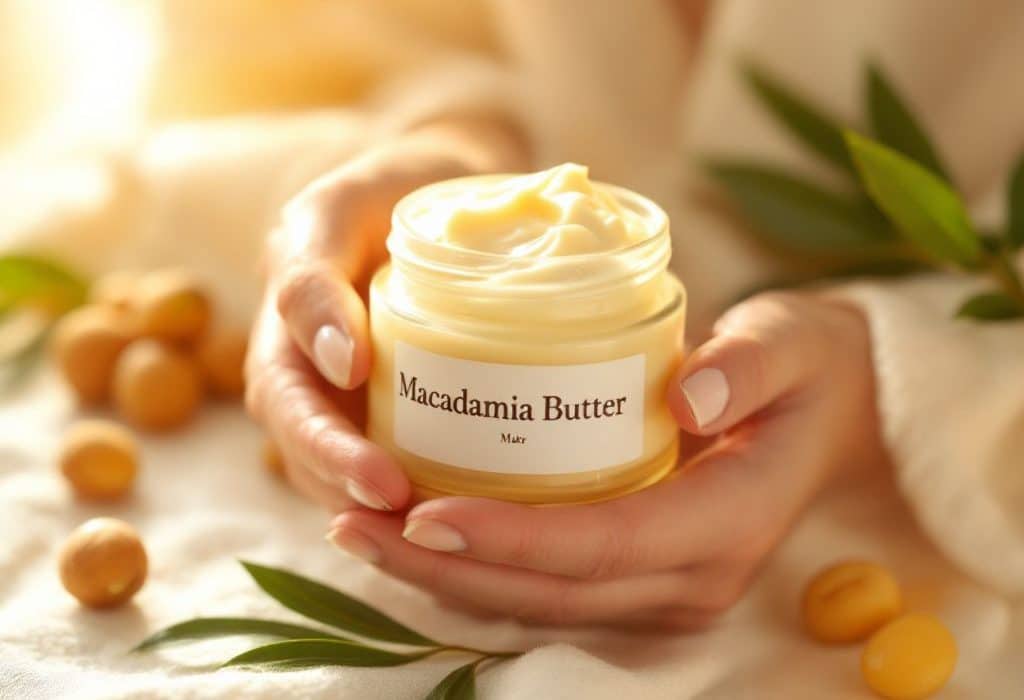So, you’ve heard about this whole “nut power” trend, and you’re curious, right? I get it—we’re all on this endless search for the next big thing in natural skin care. Drop everything for a minute and let’s chat about macadamia butter. Not quite as mainstream as coconut oil or shea butter but, trust me, it’s worth your time.
Why Choose Macadamia Butter for Natural Skin Care?
We live in a world that’s obsessed with multitasking, and guess what? Your skin care can be, too. Macadamia butter is not only an emollient but also packed with fatty acids that mimic the oils your skin produces naturally. This makes it a staple in the world of natural skin care.
Think of it as nature doing its best to keep you hydrated and glowing. The key component here is palmitoleic acid—a superstar that imbues macadamia butter with a uniquely rich and creamy texture. It’s like a hug for your skin!
What Sets Macadamia Butter Apart?
Other nuts, and their corresponding oils, just can’t compete with the magic of macadamia skin products. Not to diss almond or argan oil, but macadamias offer a distinct focus on moisture-retention and repair. Oh, and a little goes a long way, which is a bonus for anyone’s wallet.
The Science of Nut Necessity: How It Works
Getting into a little science here—with the promise it won’t get tedious—your skin is the largest organ (you already knew that, didn’t you?). Macadamia butter loves penetrating the epidermal layer, which is great because that’s where hydration plays its game.

Fatty Acids: Your New BFFs
It’s all about those fatty acids, particularly oleic and linoleic acid. They help fortify your skin’s barrier, locking in moisture like nobody’s business. Palmitoleic acid stars here due to its role in regenerating skin cells. Yeah, it’s got a flair for all things restorative.
But there’s another angle to explore. Vitamins A and E help fight off those pesky free radicals, arguably meeting your anti-aging goals without hefty price tags. Keep this in mind when you pick up that jar!
Applying Macadamia Butter: A Step-by-Step Guide
So how exactly do you use this miracle nut paste? Follow this easy-peasy guide to keep it all straightforward.
Step 1: Patch Test It Out
Have sensitive skin? Yikes, me too. The best bet is to start small. Dab a bit on your wrist or behind your ears. Hold tight for 24 hours to watch for any reactions. Getting this step done with a dollop can ease your mind later.
Step 2: Cleanse Before You Butter Up
Make sure you cleanse your skin thoroughly. And I mean, really cleanse. Apply your face wash, lather, rinse, the whole deal. Starting with a clean slate every time will let macadamia’s magic do its thing without interference.
Step 3: The Application
With macadamia butter, less really can be more. Take a small amount—your fingertip’s worth—and massage it gently onto your face in circular motions. Working it upward keeps things lifted (and fights against the sad pull of gravity).

Step 4: Daily Doses
In your routine, consistency trumps effort every time. Once or twice daily should seal the deal. Mornings and nights are ideal. A tiny spa moment for yourself twice a day? Fully important!
Little Hazards to Be Aware Of
Hey, nothing’s perfect—not even your new favorite macadamia butter. Despite its wonders, be cautious in hot climates. The oils risk going rancid if left unprotected in the blistering sun. Keep it cool, literally!
What If You Have Nut Allergies?
Alright, nut allergies are no joke. If nuts send you into sneezing or worse, bypass this little gem. There are many nut-free alternatives for natural skin care that could work instead.
Mixing Macadamia: DIY Projects
Let’s finesse your routine further with DIY options. Want to concoct your own face mask? Easy-brainer!
Simple Face Mask Recipe

- Ingredient List
- tbsp macadamia butter
- tbsp honey
- teaspoon plain yogurt
- How-To Masterpiece
- Combine all ingredients in a small bowl, mixing until smooth.
- Apply onto your clean face and let it do its magic for about 15 minutes.
- Rinse it all off with warm water, pat dry gently.
Feel free to toss in a few drops of essential oils you’re smitten with for a spa-like aroma. Trust me, your face and senses will thank you.
Comparing Macadamia to Other Nut Butters
Sounds nerdy, but take an objective view for which nut butter deserves prime real estate on your skincare shelf. Here’s a simple table to help you make the choice:
| Nut Butter | Benefits | Drawbacks |
|---|---|---|
| Macadamia | Moisturizing, rejuvenating, natural skin oils | Not ideal for hot climates, nut allergies |
| Shea Butter | Deep moisture, anti-inflammatory | Greasy texture, slow absorption |
| Almond Butter | High Vitamin E, great for sensitive skin | Can feel oily, not for nut allergies |
| Coconut Oil | Antibacterial, moisturizing | Highly comedogenic, can clog pores |
No single product will answer every skin woe, so variety might just spice things up for your skin regimen.
Wrapping Up the Nutty Goodness
Choosing macadamia butter for your natural skin care routine means partnering up with a nut that has your back, or your skin, to be precise.
Test, massage, enjoy—get involved with this delightful potion your skin’s bound to adore. Maintain its freshness and keep exploring. After all, now we know the tricks of handling macadamia, we can start bananas…or well, nuts for our new radiant, nourished skin.
Frequently Asked Questions
What are the benefits of using natural ingredients in skin care?
Using natural ingredients in skin care offers several benefits, including hydration, protection from environmental stressors, and anti-inflammatory properties. Natural ingredients like aloe vera, chamomile, and lavender provide gentle yet effective cleansing and protection for the skin. They are also free from harmful chemicals and toxins, making them suitable for sensitive or allergy-prone skin[1][3][5).
How do natural ingredients differ from synthetic ingredients in skin care?
Natural ingredients differ from synthetic ingredients in that they are sourced from plant-based materials and are minimally processed. They are rich in vitamins, antioxidants, and other beneficial compounds that can nourish and protect the skin. Unlike synthetic ingredients, natural ingredients are generally gentler and less irritating, making them a great choice for those with sensitive skin[1][3][5).
What natural ingredients are effective for anti-aging skin care?
Natural ingredients such as aloe vera, jojoba oil, green tea, and rosehip oil are effective for anti-aging skin care. These ingredients help protect the skin from aging by promoting collagen production, hydrating the skin, and providing antioxidant benefits. They are also free from harsh chemicals and toxins that can cause long-term damage to the skin[1][3][5).
Are natural skin care products eco-friendly?
Yes, natural skin care products are generally eco-friendly. They are made from biodegradable natural ingredients and do not contain synthetic additives that can harm the environment. These products have a low environmental impact as they do not leave chemical residues in the environment or pollute soil and water when washed down drains[1][5).
References

